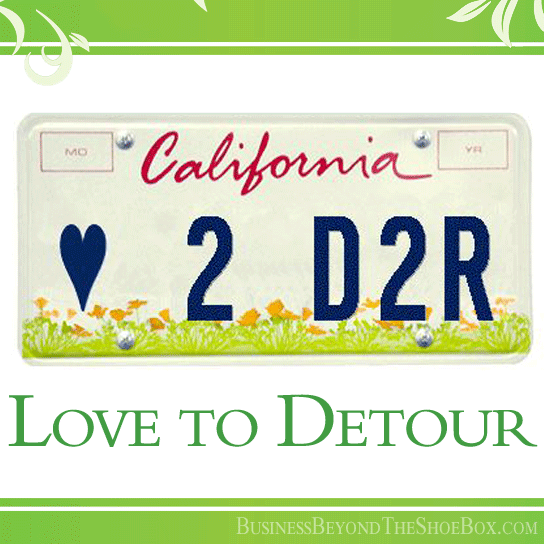My very first blog was “My Dad Always Said…” which covered his favorite saying: “It takes money to make money.” And while my dad taught me many things about how to make money with a small business, having grown up in a home with no running water to owning his own home in Sacramento through smart business decisions, there was something I learned from him that he didn’t intend to teach me: shortcuts usually don’t work.
My dad loved shortcuts, but they never worked out for us. I remember a trip we took through the hills in Santa Barbara with a big camper on the back of his truck for our vacation; he drove through a low spot which turned out to be a swamp (I know, it’s hard to believe there was that much water in California at one time). He tried to turn around, but it was too hard on the truck and the axel broke. So there he was with two little girls stuck in the back hills away from anyone or anything (and no cell phone of course because they didn’t exist yet - gasp). He had to walk 15 miles before he found someone to take him to a phone. (Note: He left us at the camper with our mother. I’m not sure who had the worse experience – his 15 mile walk or us left behind stuck in a bog with mosquitoes the size of saucers on a warm summer day.)

This was just one of many experiences I had with my dad in which the shortcut he chose created more problems than it was worth. A good result of this is my life-long enjoyment of taking the long way through scenic landscapes. I even had a license plate of “<3 2 D2R” (Love to Detour) when I had a Jeep. But there is a bigger lesson to this story: you don’t have to take the long, scenic path as you learn how to make money with a small business, but the risks of taking a shortcut can be quite perilous and not give you the results you seek.
Shortcuts in business tend to backfire in much the same way as my dad’s driving routes. Some shortcuts are tools, like keyboard shortcuts (CTRL+C to copy, for example), but shortcuts which promise fast results are the ones to stay away from. If someone emails you and tells you they can get you 1,000 new Facebook followers for $5, you would (hopefully) know it was a scam, but if you didn’t and you paid the $5 for this shortcut, you would suddenly find yourself with 1,000 new followers from spam accounts, ultimately hurting your Facebook page’s score, leading to more work in manually removing all 1,000 accounts from your page. In the end, this “shortcut” would create a lot of extra work and expense to repair all of the damage it created, much like the broken axel on my dad’s truck. You would also lose all of that valuable time you could have been using to make more money with your small business the right way.

The above example might seem easier than what many small business owners struggle with on a day-to-day basis as they learn how to make money with their business. For new business owners without training or experience, what is and is not a shortcut is a lot harder to determine. Here are a few of my business tips to help you avoid the pitfalls of the wrong shortcuts and keep you on the right path to make money with your small business:
Does it substitute for a quality experience?
McDonald’s and Ford are known for pioneering streamlined tasks. An assembly line can create a shortcut without removing the quality of the product. Selling a wine tour in Paso Robles that requires customers to use their own car rather than taking the time to get your own business shuttle, driver, and insurance is a shortcut that will absolutely take away the quality of the experience for your customers and would be a surefire way to damage the future success of your business. Using cheap ingredients in a bakery is another shortcut that might seem tempting, but if it changes the quality of the end result, it is best to stay away.
Does it complete a task “well enough”?
This tip comes from businesses with employees or virtual assistants, but applies to solopreneurs as well. Some tasks that are part of running a small business have a done-well-enough aspect to them; think about something that you do that could be completed by someone else and ask yourself if you would feel compelled to micro-manage the task or not? Putting a stamp on an envelope has a done-well-enough aspect to it as the stamp is either on the envelope in the right general area or not, and if it is slightly crooked no one is going to notice or care. Certainly some people feel the need to micro-manage everything, but those are not the people who choose shortcuts. Any shortcut that offers a solution for something that does not have a done-well-enough aspect to it is a shortcut you will likely regret.
Is it a shortcut for the vital few or the trivial many?
The Pareto Principle is a universal rule known as the 80/20 rule because it outlines the connection of 80% of the effect coming from 20% of the distribution, like 80% of your business revenue coming from 20% of your clients. This has actually been demonstrated in many cases resulting in the 20% to be known as the “vital few” which can apply to people and sales or activities for time management. If you are presented with a shortcut telling you how you can make more money with your small business, ask yourself if this is part of the vital 20% of your business activities accounting for 80% of your results, or if it is part of the trivial 80% accounting for only 20% of your revenue generation? Hopefully you are tracking where your revenue is coming from already and this will be easy to identify. If not, contact me and we’ll take a look at your revenue generation strategies together.
Keep these tips in mind the next time you see a shortcut promising you will make money with your small business by taking the shortcut. You don’t want to add a 15-mile hike onto your path to success!





